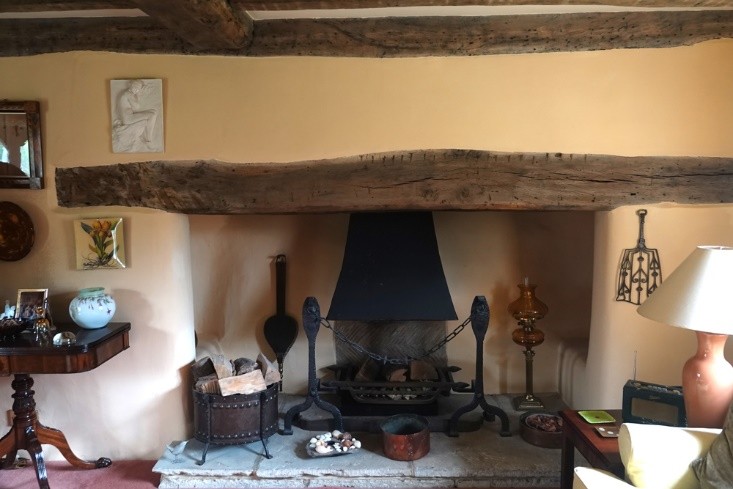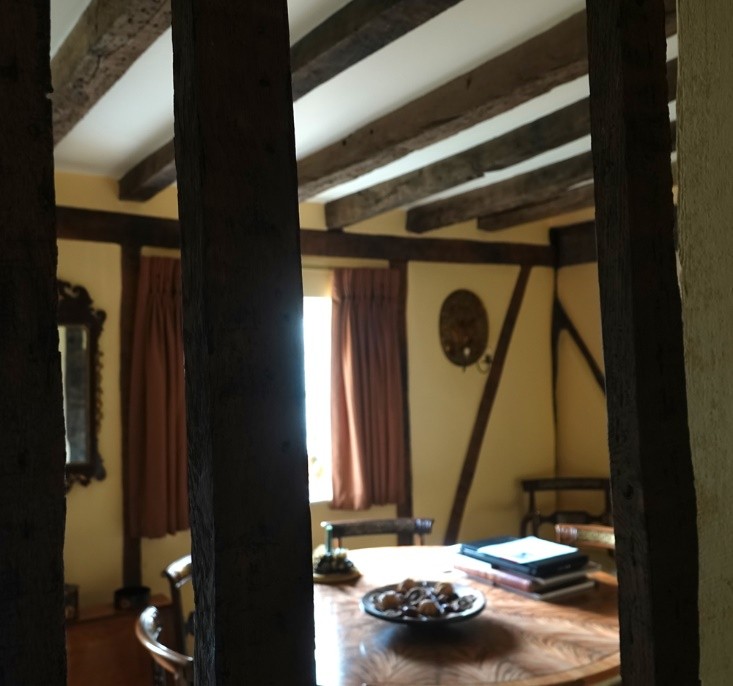
Although these two cottages are on the Listed Buildings as one listing, they are two quite separate properties
Originally listed on 18th July 1963


The Old Cottage, Front View
Source: www.britishlistedbuildings.co.uk
Farmhouse, now 2 houses. C17 and C18. Timber framing with rendered infill; coursed clunch rubble; plain-tile roofs with brick ridge stacks. 2-unit plan, extended. 2 storeys plus attics and one storey plus attics. Earlier timber-framed range has door to right and irregular casements, including small stair windows just to right of central post. Large, clustered stack rises at junction with lower rubble range to left. 4-panelled door, in line with stack, forms part of The Olde Cottage, but remainder of rubble range, with C20 extension to left, forms Quarr Cottage, and has segmental-arched openings and a dormer to front and rear. Interiors not inspected.
Quarr Cottage
Source: People & Houses, South Oxfordshire 1300 – 1650’s – Stephen Mileson
Quarr Cottage, 127 Thame Road, Warborough 1650–1700 2½ bays (incl. passage), floored from start (attic only)
Quarr Cottage is in a key location near the war memorial and Church, located on the west side of the main north south road. Middle farm is to the west, The Lilacs to the south. Attached to the west is The Olde House (sometimes referred to as Badgers Cottage) A 2½/3 bay, 1½ storey cottage of C1650 to 1700 date with unheated bay on the roadside rebuilt in 1986. Possible through passage plan. One heated room with a gable end stack, possible through plan and common raft roof with intermediate trusses. Quarr Cottage is prominently located, orientate East/West gable on to the road. It is reached over a short stone pedestrian or vehicular bridge over the Drain. Quarr Cottage may be an addition to The Olde House, attached to the west. The Old House has a flying freehold over the former access to the cottage. The name Quarr comes from Quarr Abbey on the Isle of Wight (Diana Airey, personal comment 23.07.2013). Constructed in squared coursed limestone under an old red clay tile roof, with brick stacks. The location of the 4 trusses T1-T4 shows the bay division in the roof which is mirrored in the configuration of the beams: bay 1 spans G1 and ½ of G2 (hall ad staircase bay), marked by the axial beam end with run out stop: the second bay starts in the cupboard under the stairs and terminates in G3 and is marked by the termination of the axial spine beam with the transverse beam. Beams have 2¼” chamfers and run out stops. G1 the main living space has a wide stone/brick fireplace with bressummer and lower arched brick head with plate. Bread oven on right and possible ham curing chamber on left (Diana Airey personal comments 23.07.2013) G2 is the ½ bay through passage and stair, G3 (present kitchen) Parlour with rebuilt gable end fireplace with wood burning stove: G4 is an unheated rebuilt bay on the footprint of an earlier building.
Unusual features include C17 wide plank door in F1 with cocks head hinges* and key holes on north side of stack. Bricks in G1 fireplace are of several different dates – wider bricks C17 bricks 1½ x 9¾ x 5½ and later C18/C19 bricks 2½ x 8½ x 4½
Quarr Cottage was sold by St Johns College, Oxford in the 1950’s

A cock’s head hinge
The cottage has views northwards up the main road and oblique southwards to the Church. Main access door on south into through passage with rear door to private plot adjacent to Drain and road on the east.
Marks on the brickwork of the fireplace could indicate where it was used to sharpen knives
The only bomb to fall in Warborough was at 4am on the 4th October 1940 and hit the unoccupied end of the cottage. The road was blocked and the roof of The Old Cottage was perforated by falling stone and the overhead electricity supply was cut. The village organised a collection for the affected family until official compensation was received.

The Bombed Cottage
*A cock’s head hinge is a decorative 17th-century hinge whose terminals are shape like the head of cockerels. They were used mainly on cupboards but can also be found on internal doors of the period.
The Old Cottage
Source Brian Kearsley – The Old Cottage.
Mr Kearsley has carried out a lot of research of his property and has studied the records at St John’s College and he provided the following information.
Information from St John’s College indicates it was built in the final years of Elizabeth’s I reign.
Mr Kearsley has a map dated October 1606 which shows his property and the barn behind, listed as belonging to St John’s College. It was rented to Mr Deane. It was sold in September 1954 to Mr Buswell for £575.00
Sir Thomas White (founded St Johns College) in 1556 acquired Warborough & Shillingford Manor. Eventually bequeathed to the College. His mother (Keblewhite), whose descendants rented tracts of Warborough land from the College.
1620 – Agreement between College, Ralph Keblewhite 3rd October 1603 & William Dean(e) entitled his wife, Isabella and or his son William to continue to rent after his death
1645 – Dean’s tenancy lapses following the demise of his family.
Passes to Arthur Violett, his wife Ann and his son Nicholas
1687 – Nicholas to his son Thomas Violett
1715 – Thomas Violett to John Woodward (from Norfolk)
Nothing found in Court Rolls of 1715-1740, 1741 – 1772
1777 – William Smith
1780 – No essential repairs carried out
1786 – Still no repairs completed. Forfeit to College
1787 – William dies, property taken over by son Paul. Property includes Berry Field
The Beisley family begins to be mentioned with various version of the spelling Biesley, Beesley, Beasley, Beisley
1789 – Elizabeth Beisley, widow, dies. Copyholding passes to her son, Isaac.
1789 – John Beesley becomes tenant.
1795 – John dies – 2 yards, three half acres to Richard Hyatt.
1819 – Isaac Biesley & son Joseph surrenders cards to Benson, formerly granted to William Smith & son, Richard
1831 – Joseph Biesley dies, Isaac & his daughter Elizabeth now included
1837 – Isaac dies, leaving a widow
1939 – Jane Beisley
???? – The full dates are not confirmed but since publication we have been told that one of the Bailey families lived at The Old Cottage. Brian Bailey was born there in 1947 and lived with his father and mother, Len & Mollie, as well as his grandparents Ernest & Harriet Bailey.
8th September 1954 – St John’s sells cottage to John Buswell, for £575.00
13th May 1960 – John Buswell sells to Mr & Mrs M Holloway for 5850.00
1st May 1968 – Mr & Mrs Holloway to Mrs O’Neil
3rd April 1976 – Mr J Hayward purchased estate consisting of 529 acres, one cottage £8000.00 Land adjacent to cottage for drive.
9th July 1976 – Mrs O’Neil to Mr & Mrs Van Brugen for £28500.00
July 1982 – Mr & Mrs Van Brugen to Michael & Pauline Hodges
1989 – 1995 Stephen & Deborah Dance
1994 – Mr & Mrs S Dance to Christina Scott
September 1997 – C Scott to Mr Kearsley for £278,500
Mr Kearsley says evidence was found of smoke on beams and believes it was a tenant farmers house and Quarr Cottage built on. The sole plate was replaced by Mr Kearsley due to wood rot and the floor is 17th Century.


The Dining Room

The bedroom
Compiled by Lynda Raynor.
Photos credit to Ray Thackrah